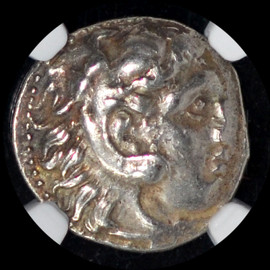PHRYGIA. Cibyra. 2nd-1st Centuries BC. AR drachm (15mm, 1h). NGC Choice XF, Head of Cibyras in crested Attic helmet right / ΚΙΒΥΡΑΤΩΝ, Cibyras charging right on horseback with couched spear in hand, shield on back; eagle behind. BMC 8. SNG von Aulock 3709 var. (symbol). SNG Copenhagen
 |
In classical antiquity, Phrygia (/ˈfrɪdʒiə/, FRIJ-ee-ə; Ancient Greek: Φρυγία, Phrygía [pʰryɡía]) (also known as the Kingdom of Muska) was a kingdom in the west central part of Anatolia, in what is now Asian Turkey, centered on the Sangarios River. After its conquest, it became a region of the great empires of the time.
Stories of the heroic age of Greek mythology tell of several legendary Phrygian kings:
Gordias, whose Gordian Knot would later be cut by Alexander the Great
Midas, who turned whatever he touched to gold
Mygdon, who warred with the Amazons
According to Homer's Iliad, the Phrygians participated in the Trojan War as close allies of the Trojans, fighting against the Achaeans. Phrygian power reached its peak in the late 8th century BC under another, historical, king: Midas, who dominated most of western and central Anatolia and rivaled Assyria and Urartu for power in eastern Anatolia. This later Midas was, however, also the last independent king of Phrygia before Cimmerians sacked the Phrygian capital, Gordium, around 695 BC. Phrygia then became subject to Lydia, and then successively to Persia, Alexander and his Hellenistic successors, Pergamon, the Roman Empire and the Byzantine Empire. Over this time Phrygians became Christian and Greek-speaking, assimilating into the Byzantine state; after the Turkish conquest of Byzantine Anatolia in the late Middle Ages, the name "Phrygia" passed out of usage as a territorial designation.










